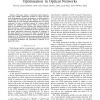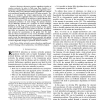108
Voted
TCOM
2010
14 years 10 months ago
2010
—This paper analyzes the quality of service (QoS) of scheduling algorithms for heterogeneous users in multiuser (MU) wireless systems that take advantage from a crosslayer design...
118
Voted
TCOM
2010
14 years 10 months ago
2010
In this paper we formally analyze the interleaver and code design for QAM-based BICM transmissions using the binary reflected Gray code. We develop analytical bounds on the bit e...
88
Voted
TCOM
2010
14 years 10 months ago
2010
Multiple subcarrier modulation is an appealing scheme for high-data rate optical communication. However a major drawback is its low average power efficiency. While subcarrier res...
113
click to vote
TCOM
2010
14 years 10 months ago
2010
Abstract—This paper studies a constrained optical signal-tonoise ratio (OSNR) optimization problem in optical networks from the perspective of system performance. A system optimi...
TCOM
2010
14 years 10 months ago
2010
—Resource allocation promises significant benefits in wireless networks. In order to fully reap these benefits, it is important to design efficient resource allocation algori...
TCOM
2010
14 years 10 months ago
2010
Abstract—In this paper, we propose a spectrally efficient cooperative transmission protocol for multiple access scenarios. The key feature is to utilize multi-user diversity and...
82
Voted
TCOM
2010
14 years 10 months ago
2010
Abstract—Framed Slotted Aloha (FSA) is a popular anticollision technique in state-of-the-art RF-ID systems, as in ISO/IEC CD 18000-6 for 900MHz or the EPCglobal HF Gen 2 draft fo...
113
click to vote
TCOM
2010
14 years 10 months ago
2010
We consider two nodes equipped with multiple antennas that intend to communicate i.e. both of which transmit and receive data. We model the responses of the communication channels...
133
Voted
TCOM
2010
14 years 10 months ago
2010
Bidirectional relaying is a promising approach to improve the performance in wireless networks such as sensor, ad-hoc, and even cellular systems. Bidirectional relaying applies to...
107
click to vote
TCOM
2010
14 years 10 months ago
2010
—Bit-interleaved coded modulation (BICM) is often the method of choice for multilevel transmission over fading channels. If relatively simple forward error-correction (FEC) codes...


